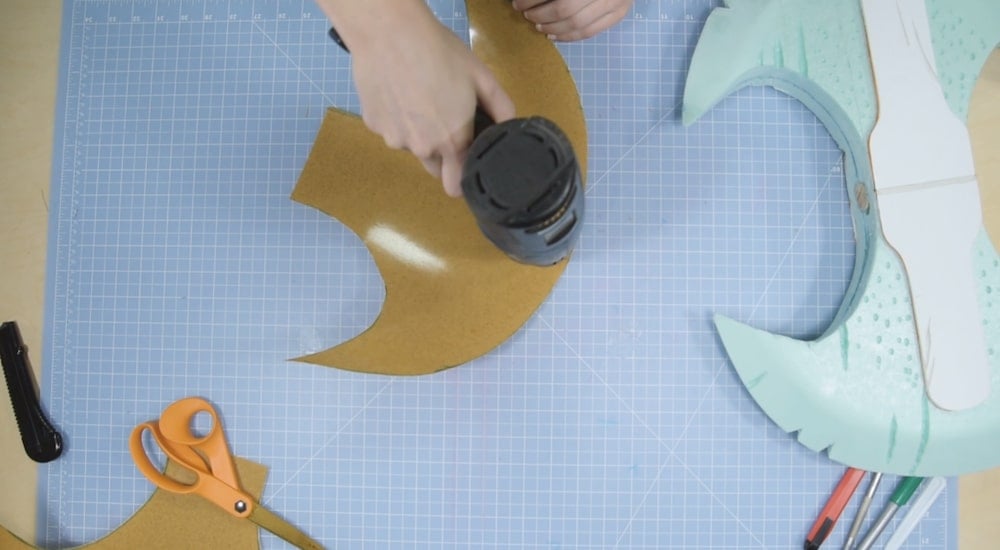Thermoplastics like Worbla, Wonderflex, and more have become a huge part of modern cosplay. Once you’ve got the hang of sculpting and heat forming thermoplastic, you can make some really impressive armor, props, accessories, and more. But working with thermoplastic is different than building with foam, cardboard, and even other plastics in a variety of ways, including which adhesives you can use for which applications. So when you’re assembling your thermoplastic pieces, which glue should you use?
Thankfully, with thermoplastic, you have a few options. In this post, we’ll explain how to glue thermoplastics with the best adhesives for the material as well as which adhesives can potentially be used to prime its rough texture.
Best Adhesives for Thermoplastics

- Thermoplastic self-adhesive: Several thermoplastics, including Worbla’s Finest Art, have self-adhesive built right into the material. The self-adhesive is activated when the thermoplastic is heated, and you can press the adhesive side of the material directly to whatever you’re trying to stick it to: pieces of thermoplastic, foam, other plastics, and more. This self-adhesive is integrated right into the design of many thermoplastics (though not all) for your convenience, but for certain applications, like end seams, you might need something else to really reinforce your bond.
- Double-sided Attach & Build sheets: Attach & Build double-sided adhesive sheets are ideal for creating a stronger bond between your thermoplastic and whatever it is you’re sticking it to. Attach & Build is super easy to use: all you need to do is cut the sheet into the size or length you need, then peel and stick. The bond is strong and instant, and Attach & Build is non-toxic and mess-free, so you can use it indoors and in small spaces without any harm to yourself or your workspace.
- 2-part epoxy: 2-part epoxy glues are incredibly powerful adhesives that work on a variety of materials including thermoplastics. When the two parts of the adhesive are mixed, they create a super-strong chemical bond that can hold a lot of weight, which can be perfect for adhering larger or heavier thermoplastic pieces. 2-part epoxies can also be used to attach metals to thermoplastics, and metals are notoriously tricky to glue. Epoxies are a great match for plastics in general, and your cooled and hardened thermoplastic will behave like a regular plastic.
- Contact cement: According to Worbla’s website, contact cement is a great adhesive for your cooled thermoplastic pieces. As always, contact cement is toxic and should only be used in a well-ventilated area and with a respirator, but it provides a strong, permanent hold. Because of its brush-on formula, contact cement is best for covering larger surface areas of your thermoplastic that you want to stick something to. For end seams or smaller items that you want to glue down, contact cement might not be the most convenient, but it should still work for you.
- Super glue: Finally, super glue (or cyanoacrylates, whichever you call it) is also a valid adhesive option for thermoplastics. Because most super glue dries clear, it’s a good choice for any joins that are visible or on the outside your cosplay. Because super glue comes in such small bottles with a squeeze tip applicator, it would be best for smaller bonding applications like seams and gluing small items or embellishments to your thermoplastic, like adding google-eye screw head details before painting, for example.
Priming Thermoplastics with Adhesives
Another characteristic of thermoplastic is that whenever it is stretched and formed under heat, the surface texture is rough and pitted, which is not usually ideal for painting and detailing. In order to smooth the texture of your thermoplastic pieces, you’ll likely need to prime the material with some kind of coating, as well as potentially sanding the rough edges and surfaces. Thankfully, you have several different options for priming your stretched thermoplastic. On one hand, you can use a designated priming material, like a priming spray, Flexbond, or Gesso. However, there are also several adhesives you may already have on hand that will also work as thermoplastic primers.
On the adhesive side, brushing on thin coats of wood glue that’s been thinned with water can give you a relatively flat surface to work with. White school glue is another priming option that’s sometimes used for foam but could also be used to create a smooth coating for thermoplastic. Different primers can yield different results when painted over and weathered, so looking into demos and comparisons as well as testing the different types out for yourself will give you the best idea of what types of primers work best for you, your budget, and your cosplay process.